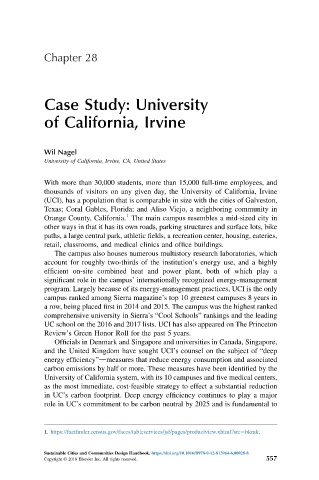Page 590 - Sustainable Cities and Communities Design Handbook
P. 590
Chapter 28
Case Study: University
of California, Irvine
Wil Nagel
University of California, Irvine, CA, United States
With more than 30,000 students, more than 15,000 full-time employees, and
thousands of visitors on any given day, the University of California, Irvine
(UCI), has a population that is comparable in size with the cities of Galveston,
Texas; Coral Gables, Florida; and Aliso Viejo, a neighboring community in
1
Orange County, California. The main campus resembles a mid-sized city in
other ways in that it has its own roads, parking structures and surface lots, bike
paths, a large central park, athletic fields, a recreation center, housing, eateries,
retail, classrooms, and medical clinics and office buildings.
The campus also houses numerous multistory research laboratories, which
account for roughly two-thirds of the institution’s energy use, and a highly
efficient on-site combined heat and power plant, both of which play a
significant role in the campus’ internationally recognized energy-management
program. Largely because of its energy-management practices, UCI is the only
campus ranked among Sierra magazine’s top 10 greenest campuses 8 years in
a row, being placed first in 2014 and 2015. The campus was the highest ranked
comprehensive university in Sierra’s “Cool Schools” rankings and the leading
UC school on the 2016 and 2017 lists. UCI has also appeared on The Princeton
Review’s Green Honor Roll for the past 5 years.
Officials in Denmark and Singapore and universities in Canada, Singapore,
and the United Kingdom have sought UCI’s counsel on the subject of “deep
energy efficiency”dmeasures that reduce energy consumption and associated
carbon emissions by half or more. These measures have been identified by the
University of California system, with its 10 campuses and five medical centers,
as the most immediate, cost-feasible strategy to effect a substantial reduction
in UC’s carbon footprint. Deep energy efficiency continues to play a major
role in UC’s commitment to be carbon neutral by 2025 and is fundamental to
1. https://factfinder.census.gov/faces/tableservices/jsf/pages/productview.xhtml?src¼bkmk.
Sustainable Cities and Communities Design Handbook. https://doi.org/10.1016/B978-0-12-813964-6.00028-8
Copyright © 2018 Elsevier Inc. All rights reserved. 557

